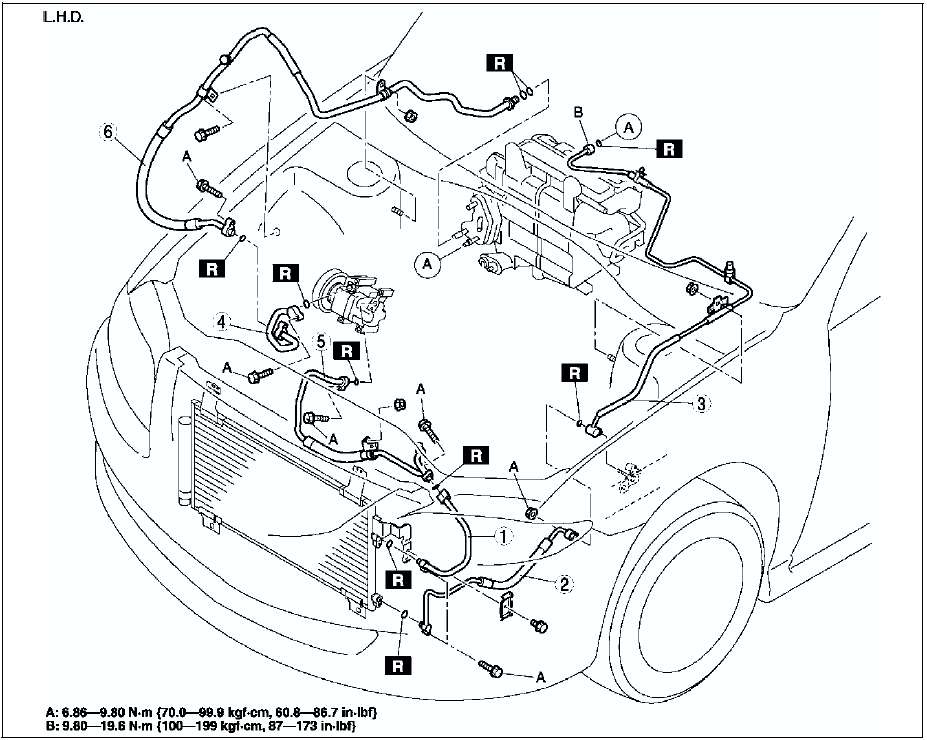Mazda 6 Service Manual: Refrigerant lines removal/installation
1. Remove the battery.
2. Discharge the refrigerant from the system. (See RECOVERY.) (See CHARGING.)
3. Remove the washer tank. (L.H.D. only) (See WASHER TANK REMOVAL/INSTALLATION.)
4. Remove the air cleaner cover, air cleaner element and air cleaner case.
(See INTAKE-AIR SYSTEM
REMOVAL/INSTALLATION.)
5. Remove the charcoal canister.
6. Remove the No.3 engine mount. (L.H.D. only)
7. Remove the shroud panel. (See SHROUD PANEL REMOVAL/INSTALLATION.)
9. Remove the right splash shield.
10. Remove the right mud guard. (L.H.D. only)
Caution
- If moisture or foreign material enters the refrigeration cycle, cooling ability will be lowered and abnormal noise will occur. Always immediately plug all open fittings after removing any refrigeration cycle parts to keep moisture or foreign material out of the cycle.
10. Remove in the order indicated in the table. Do not allow compressor oil to spill.
11. Install in the reverse order of removal.
12. Perform the refrigerant system performance test. (See REFRIGERANT SYSTEM PERFORMANCE TEST.)



Refrigerant Lines Removal Note
Nut joint type
Loosen the nut using two spanners, then remove the cooler pipe or hose.
Block joint type
Disconnect the block joint type pipes by grasping female side of the block with pliers or similar tool and holding firmly, then remove the connection bolt or nut.

Spring-lock coupling type
1. Set the SST
.

2. While looking through the inspection hole of the SST
, insert the protruding part of the SST
until it makes contact with the cage section.

3. Use the SST
to disconnect the male pipe or hose from the female by pulling the male pipe or hose.
Note
- The male pipe or hose can be disconnected easily from the female pipe by pulling from the male pipe or hose while maintaining the pressure of the protruding part of the SST.

Refrigerant Lines Installation Note
1. When installing a new cooler pipe No.4 or cooler hose (LO), add a supplemental amount of ATMOS GU10 compressor oil into the refrigeration cycle.
Supplemental amount (approximate quantity) 5 ml {5 cc, 0.2 fl oz}: Cooler pipe No.4 10 ml {10 cc, 0.3 fl oz}: Cooler hose (LO)
2. Apply compressor oil to the O-rings and connect the joints.
3. Tighten the joints.
Nut or block joint type
1. Tighten the nut or bolt of joint by hand.
2. Tighten the joint to the specified torque. If it is a nut joint, tighten the nut with a spanner and torque wrench.
3. Connect the block joint type pipes by grasping the female side of the block with pliers or similar tool and holding firmly, then tighten the connection bolt or nut with a torque wrench.

Spring-lock coupling type
Connect the male pipe or hose by twisting it onto female pipe until the garter spring at the male pipe or hose is over the flared end of female pipe.
Note
- When the male pipe or hose is replaced, the indicator ring comes out after connecting to indicate that it is locked.

 Condenser inspection
Condenser inspection
1. Inspect for cracks, damage, and oil leakage.
If any are found, replace the condenser.
2. Inspect for fins clogged by dust.
If any are clogged, remove the dust from the fins.
3. Inspec ...
 Control system
Control system
...
Other materials:
Mazda 6 Service Manual: Foreword
Caution
When the engine does not start or stalls and the following DTCs
are not indicated, go to engine symptom troubleshooting.
Note
When the immobilizer system is defective, the engine cannot be
started.
If engine condition is normal but light stays on, inspect for
short circ ...
Mazda 6 Service Manual: Dtc table
DTCs are common for present and past malfunction diagnosis.
Note
When DTCs not shown in the DTC table are displayed, replace
the SAS unit.
If the air bag system warning light does not illuminate or
remains illuminated when the ignition switch is turned to ON position,
i ...
